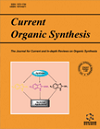- Home
- A-Z Publications
- Current Organic Synthesis
- Previous Issues
- Volume 10, Issue 6, 2013
Current Organic Synthesis - Volume 10, Issue 6, 2013
Volume 10, Issue 6, 2013
-
-
Green Chlorination of Organic Compounds Using Trichloroisocyanuric Acid (TCCA)
More LessAuthors: Gabriela F. Mendonca and Marcio C.S. de MattosThe present review summarizes the synthetic application of trichloroisocyanuric acid [1,3,5-trichloro-1,3,5-triazine-2,4,6- (1H,3H,5H)-trione] as a convenient reagent for the electrophilic chlorination of unsaturated carbon-carbon bonds and focuses on its green aspects. Chlorination reactions involving alkenes, alkynes, arenes, and (di)carbonyl compounds and the chlorodecarboxylation of cinnamic acids (Hunsdiecker reaction) Read More
-
-
-
Alternative Methodologies for Halogenation of Organic Compounds
More LessIt is difficult to imagine organic chemistry without organo-halogen compounds and the molecular halogens needed for their preparation. In fact, It is implied that halogenation of organic compounds is a key industrial process; for example, the halogenated products are used in the synthesis of many pesticides and pharmaceuticals. Conventional halogenation methods typically use pollutant, toxic and corrosive elemental haloge Read More
-
-
-
Bromide-bromate Couple of Varying Ratios for Bromination, Vicinal Functionalisation and Oxidation in a Clean Manner
More LessThe review highlights applications of bromide-bromate couple in organic synthesis. The couple having 5:1 mole ratio of bromide to bromate is useful for preparation of dibromo derivatives from alkenes/alkynes. The 2:1 couple affects substitution with high bromine atom efficiency. Vicinal functionalization of olefins has also been studied. The 1:8 bromide-bromate couple has proved promising in several oxidation reactions, Read More
-
-
-
Chiral Sulfoxides as Building Blocks for Enantiopure 1,3-Diol Precursors in the Synthesis of Natural Products
More LessAuthors: Claude Bauder, Jean Martínez and Xavier J. Salom-Roig1,3-Diol motif is of particular interest due to its prominence within many classes of natural products. In this field, β,δ-diketo sulfoxides are specially attractive because both syn- and anti-1,3-diols can be prepared from these key compounds by two successive high diastereoselective reductions of both carbonyls. Thus, β-carbonyl reduction requires DIBAL-H or the ZnX2/DIBAL-H system. The resulting stereochemistry of the corresp Read More
-
-
-
Recent Advances in the Syntheses of Nucleoside Triphosphates
More LessAuthors: Anilkumar R. Kore and Balasubramanian SrinivasanThe present review compiles significant advances in different synthetic strategies to obtain various nucleoside triphosphates, which are indispensable materials for variety of important biological applications such as DNA sequencing, PCR, therapeutic nucleoside inhibitors of polymerase, to prepare apatamers by in vitro transcription methods, and ingredients in numerous biological assay kits. Modified nucleos Read More
-
-
-
Smiles Rearrangement in Synthetic Chemistry
More LessAuthors: Shuai Xia, Li-Ying Wang, Hua Zuo and Zhu-Bo LiSmiles rearrangement, an organic intramolecular nucleophilic aromatic substitution reaction, provides a powerful access to the synthesis of a variety of heterocyclic compounds. In contrast with the conventional protocols for the preparation of complex molecular structures, Smiles rearrangement, through the conversion of an easily-synthesized precursor into a desired “difficult-to-make’’ product, presents to be an Read More
-
-
-
A Facile and Quick Synthesis of 9-aryl-substituted-acridines Mediated by DMP
More LessAn unexpected three components reaction was developed for acridine synthesis in solvent free medium. The reaction is carried out with commercial reagents using of microwaves in a heterogeneous medium in presence of zinc chloride and 2,2-dimethoxypropane (DMP) as water scavenger. Principal advantages of the method are: short time, high yields and easy work-up.
-
-
-
Aza-Diels-Alder Reaction Between 1,2-Diaza-1,3-dienes and β-Aryl-α,β-unsaturated Carbonyl Compounds. Easy One-pot Entry to 2’-Oxo-imidazo[1’,5’- f]tetrahydropyridazine
More Less1,2-Diaza-1,3-dienes bearing electron withdrawing groups react with α,β-unsaturated carbonyl compounds by means of an uncommon aza-Diels-Alder reaction furnishing functionalized tetrahydropyridazines. The regioselectivity of the process is governed by the nature of the β substituent of the α,β-unsaturated carbonyl compounds. In the case of β aryl-α,β-unsaturated carbonyl compounds the formed tetrahydropyridazines Read More
-
-
-
Synthesis of Asymmetric Diaryl Sulfides by SNAr Reaction of Substituted Nitrobenzene with Aryl Disulfides
More LessAuthors: Naoki Enjo, Rong Lu and Tetsuo MiyakoshiA series of sulfides was successfully synthesized from nitroarenes by SNAr reaction via elimination of a nitro or phenylsulfonyl group. The SNAr reaction mechanism is found to depend on the position and type of substituents, and the effect of two-electron withdrawing groups was also examined.
-
-
-
First Girgensohnine Analogs Prepared Through InCl3-catalyzed Strecker Reaction and their Bioprospection
More LessAuthors: Leonor Y. Vargas Mendez and Vladimir V. KouznetsovAn efficient preparation of the girgensohnine and its close analogs with α-aminonitrile structure, and their spectral characterization were reported for the first time. The piperidine α-aminonitriles were obtained through 5 mol% InCl3-catalyzed one-pot Strecker reaction, and tested for antioxidant activity and AChE inhibitory properties. It was found that girgensohnine possesses a moderate AChE inhibitory property while Read More
-
-
-
One-Pot Synthesis of 5-Unsubstituted-6-Aroyl[1,2,4]triazolo[1,5-a]pyrimidine Utilizing Biginelli-Like Multicomponent Reaction of Enaminones with 3-Amino-1,2,4- triazole as the Urea Component
More LessAuthors: Huwaida M.E. Hassaneen and Ismail A. AbdelhamidA novel and facile Biginelli-like assembly employing enaminones, aldehydes and 3-amino-1,2,4-triazole has been developed, which provides a novel synthesis of new 5-unsubstituted-6-aroyl-[1,2,4]triazolo[1,5-a]pyrimidine derivatives.
-
Volumes & issues
-
Volume 22 (2025)
-
Volume 21 (2024)
-
Volume 20 (2023)
-
Volume 19 (2022)
-
Volume 18 (2021)
-
Volume 17 (2020)
-
Volume 16 (2019)
-
Volume 15 (2018)
-
Volume 14 (2017)
-
Volume 13 (2016)
-
Volume 12 (2015)
-
Volume 11 (2014)
-
Volume 10 (2013)
-
Volume 9 (2012)
-
Volume 8 (2011)
-
Volume 7 (2010)
-
Volume 6 (2009)
-
Volume 5 (2008)
-
Volume 4 (2007)
-
Volume 3 (2006)
-
Volume 2 (2005)
-
Volume 1 (2004)
Most Read This Month
Article
content/journals/cos
Journal
10
5
false
en


